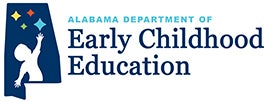
Workforce Development
Earn a Graduate Certificate in Infant and Early Childhood Mental Health from Troy University. Social and emotional development is something that can be fostered from birth throughout life. However, earlier is always better when addressing problems in these areas for children. If you are someone who has a heart for helping, a love for children and the desire to impact the mental health of our future generations, let Troy University equip you with the skills needed. For more information, click the link below.
Accreditation for Trainers
The Alabama Department of Early Childhood Education (ADECE) is pleased to announce that one-time grant funds up to $10,000 will be awarded to Alabama’s higher education institutions to pursue a program whereby the sponsoring institution will organize, plan and manage logistics in order to offer the Teaching Strategies® Accreditation Program for Trainers (APT). The program prepares participants to deliver training that promotes teachers’ reliable use of the Teaching Strategies® curriculum and assessment tool. ADECE will award these one-time grants through a competitive application and review process. Applications are due by the end of March each year.
Background
The MyTeachingStrategies™ Gold assessment tool is currently used in all Alabama First Class Pre-K classrooms, the Alabama Pre-K – 3rd Grade Integrated Approach to Early Learning Pilot, Head Starts, and some DHR family childcare and DHR child care classrooms. The mission of Teaching Strategies® is to advance the early childhood field through high-quality, integrated resources; responsive, ongoing support; and research-based, research-proven solutions that enable every early childhood educator to open doors to lifelong learning. Teaching Strategies® created an Accreditation Program for Trainers (APT) that prepares participants to deliver training that promotes teachers’ reliable use of Teaching Strategies® curriculum and the assessment tool. Accredited trainers assist teachers in understanding the developmental levels of children in their classrooms and empower them to use the curriculum materials and assessment data to individualize instruction, as well as communicate with families and other stakeholders.
Grant Requirements
To apply for funding, a sponsoring institution must:
- Be a regionally-accredited institution of higher education located in the state of Alabama;
- Have an articulation agreement already in place or can show that the institution is working toward finalizing such an agreement for early childhood and/or child development courses (in addition to STARS); and
- Provide documentation to the ADECE on the progress of this work;
- Commit to upholding Teaching Strategies® professional development competencies as well as APT trainer core competencies and guidelines;
- Commit to managing all logistics for ongoing Teaching Strategies® training, including:
- Handling the selection process for APT trainer(s)
- Choosing the topic (Creative Curriculum or TS GOLD platform) for APT trainer(s) [APT trainer(s) must be trained in TSGOLD platform before applying for the Creative Curriculum topic]
- Advancing workforce development for teachers through the APT trainer(s)
- Arranging for a training facility with adequate space for all attendees
- Providing ongoing monitoring of APT trainer(s)
- Maintaining records of the training services provided by APT trainer(s)
- Encourage higher education collaboration with ADECE for a three-year period in relation to APT training and assure APT trainer(s) conduct three (3) trainings per year for the agency.
Grant Application
If you have any questions regarding the application process or requests for further information, please contact Jean Allen at 334-314-0023 or jean.allen@ece.alabama.gov. Follow the link below to apply.
Teacher Certification/ Field Experience/Internship Site for ECE Majors
Effective July 1, 2016, and applicable to early childhood education (ECE) and early childhood special education programs: 1. Field experiences shall include placements in at least two of the three main types of early education settings (early school grades (K–3), child care centers and homes, and Office of School Readiness programs). 2. The internship shall include a placement with at least two of the following age groups: birth–age 3, age 3–5, age 5–8. To ensure that placements are made in quality programs, The Alabama Department of Early Childhood Education has provided a list of approved classrooms. If you have any questions, please contact your Region Director.
Memorandum from Alabama Departments of Education and Early Childhood Education (Implementation of the 2015 Educator Preparation Chapter of the Alabama Administrative Code)
Why LETRS?
Alabama is committed to supporting Pre-K–Grade 3 teachers with the tools necessary to teach every student the basic literacy skills needed to be successful in school. This comprehensive training will provide the P-3 teacher deeper understanding of the science of reading and evidence-based strategies necessary to support students who experience reading challenges. Learn more about Alabama LETRS:
Language Essentials for Teachers of Reading and Spelling (LETRS) can be a critical component in the teacher’s instructional toolbox of reading strategies. The LETRS is not a curriculum or program; instead, LETRS focuses on the science of reading and supports teachers in diagnosing reading issues, prescribing a strategy and assessing the effectiveness of the instruction provided to support the student.
This intensive learning experience will be provided, on a voluntary basis, for Alabama P-3 teachers and coaches. If the demand exceeds funds, a rubric with weighted criteria will be used to finalize eligibility. The Alabama State Department of Education and DECE are committed to identifying opportunities to fund additional LETRS training in the future.
